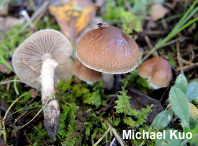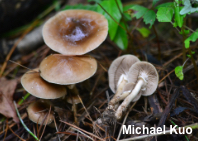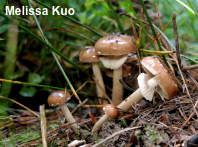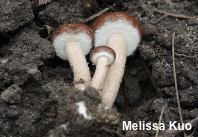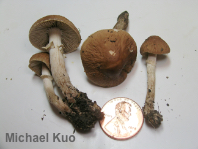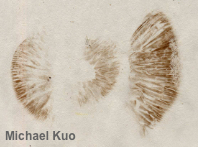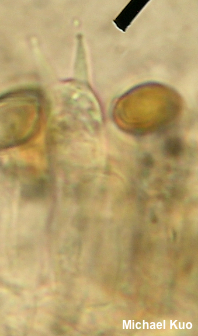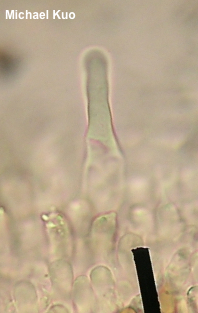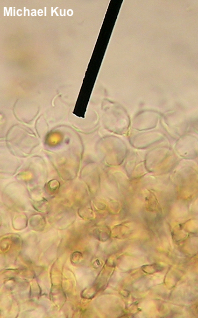| Major Groups > Gilled Mushrooms > Dark-Spored > Agrocybe & Cyclocybe > Cyclocybe erebia |

|
Cyclocybe erebia [ Basidiomycota > Agaricales > Strophariaceae > Cyclocybe . . . ] by Michael Kuo This mushroom isn't particularly common in North America (it's missing from most of our continent's field guides), but it isn't rare, either. Although it is fairly widely distributed (see below) it seems to be most common in the upper Midwest and in the mid-Atlantic states. When fresh, Cyclocybe erebia has a dark brown, sticky cap that is often a little bit wrinkled. Its gills run down the stem by a decurrent tooth, there is a flimsy, flaring ring on the stem, and the spore print is brown. Under the microscope it features two-spored basidia and spores that often feature a pinched, slightly "snout-nosed" end. Cyclocybe erebia is featured as "Agrocybe erebia" in most treatments, but recent DNA research (Vizzini, Angelini & Ercole 2014) makes it clear that this species, along with Description: Ecology: Saprobic; growing scattered or gregariously on the ground in woods under hardwoods or conifers, and sometimes found in urban settings like gardens and parks; summer and fall; in North America widely distributed east of the Rocky Mountains, but also reported from the Pacific Northwest; also found in Europe and Oceania. The illustrated and described collections are from Illinois and Ohio. Cap: 1.5–5 cm; nearly round in the button stage, expanding to convex and eventually planoconvex, sometimes with a low central bump; dark brown when fresh; fading to dull tan; sticky when fresh; bald; often a little wrinkled, especially over the center when young; with whitish partial veil remnants on the margin; margin sometimes becoming lined with maturity. Gills: Beginning to run down the stem with a decurrent tooth; close; whitish at first, maturing to pale brown; short-gills frequent. At first the gills are covered by a white partial veil. Stem: 4–8 cm long; 3–10 mm thick; more or less equal; bald or finely pruinose; whitish, becoming brownish from the base up; with a white, flaring ring that may collapse or disappear by maturity. Flesh: White to brownish; not changing when sliced. Odor and Taste: Odor not distinctive; taste slightly bitter. Chemical Reactions: KOH gray or negative on cap surface. Spore Print: Brown. Microscopic Features: Spores 10–15 x 5–7 µm; subellipsoid to subamygdaliform, often with a narrowed, "snout-like" end; smooth; brownish to brownish yellow in KOH; orangish-brownish in Melzer's reagent. Basidia 2-sterigmate. Cheilocystidia 25–40 x 5–7.5 µm; narrowly lageniform or subcylindric; smooth; thin-walled; hyaline in KOH. Pleurocystidia 30–75 x 7.5–12.5 µm; lageniform; smooth; thin-walled; hyaline in KOH. Pileipellis hymeniform; brownish to brown in KOH. Clamp connections not found. REFERENCES: (Fries, 1821) Vizzini & Matheny, 2014. (Smith, Smith & Weber, 1979; Watling, 1982; Phillips, 1991/2005; Barron, 1999; McNeil, 2006; Kuo & Methven, 2014; Vizzini, Angelini & Ercole, 2014; Ryman, 2018; Læssøe & Petersen, 2019.) Herb. Kuo 06100305, 10090304, 10021201, 09191701, 11031702. This site contains no information about the edibility or toxicity of mushrooms. |
© MushroomExpert.Com |
|
Cite this page as: Kuo, M. (2020, August). Cyclocybe erebia. Retrieved from the MushroomExpert.Com Web site: http://www.mushroomexpert.com/cyclocybe_erebia.html |
